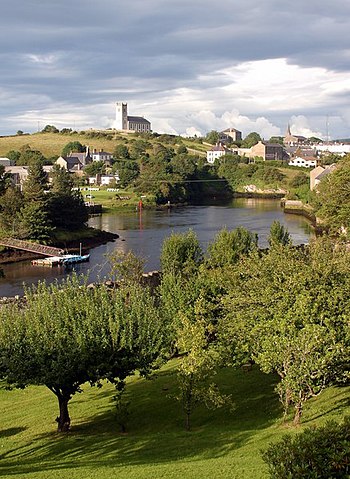River Erne
The River Erne is known as the major river of Fermanagh, though it flows through three Ulster counties; Cavan and Donegal in the Irish Republic and between them Fermanagh in the United Kingdom.
The Erne rises in Beaghy Lough, two miles south of Stradone in County Cavan and flows 64 miles through Lough Gowna, Lough Oughter and across the border to open into Upper Lough Erne, and through Enniskillen before entering Lower Lough Erne. After the lough is a short tidal stretch cutting across the neck of County Donegal to the sea at Ballyshannon. http://wikishire.co.uk/w/index.php?title=Category:Rivers_of_County_Donegal&action=edit&redlink=1 For 30 miles from Crossdoney in County Cavan to Enniskillen in Fermanagh, it is difficult to distinguish the river as it winds its way through interconnected loughs or parts of loughs nestling among the drumlin hills of Cavan and south Fermanagh.[1]
The river is 75 miles long and is very popular for fly fishing for trout and salmon, with a number of fisheries along both the river itself and its tributaries. The town of Enniskillen is mostly situated on an island in the river, between Upper and Lower Lough Erne. It is linked to the River Shannon by the Shannon–Erne Waterway.
The River Erne's basin is 1,688 square miles.[2]
Name
The river is believed to take its name from a mythical princess named Éirne.
Pleasure boating
The River Erne is suited to all types of pleasure craft and popular for it. Live-aboard pleasure cruisers are available in many locations along the Erne waterway, including Belturbet, Knockniny, Carrybridge, Bellanaleck, Enniskillen, and Killadeas. In addition to the use of the Erne for live-aboard boating holidays, sections of the river are ideal for water skiing, bank fishing, trolling, jet skiing and scuba diving. Nevertheless, boaters are cautioned that Upper Lough Erne is a maze of small islands needing careful navigation, and waves on Lower Lough Erne can reach "open-sea dimensions".
It is believed that in 2009 Donald Attig, at 73 years of age, established benchmark records in both endurance challenge and adventure challenge categories, as the first person to complete a single-handed transit of the entire Erne Navigation in an engineless live-aboard pleasure boat. After an official launch by the South African ambassador to Ireland, Attig started his engineless transit at the end of navigation marker at Belturbet, County Cavan and completed the engineless transit at the end of navigation marker Belleek.
Ancient ruins
The Erne waterway is home to abundant ancient ruins, both Christian and pagan, making up a treasure trove that is a destination for photographers and historians. Significant ruins can be found at in several locations, including: Crom Estate, on the North bank of the Upper Erne channel, Gad Island, near Crom Estate, Devenish Island, Inismacsaint Island, Davy’s Island, White Island, and Boa Island. Many of these locations can only be reached by boat.
Boa Island has one of the most unique pre-Christian statues in Ireland, and Inismacsaint has what is reputed to be the oldest large stone cross in Ireland. Devenish Island has a historical display centre adjacent to its ruins.
Angling
The building of hydroelectric power stations at Cliff (near Belleek) and Ballyshannon (work began in 1945 and the first power station was commissioned in 1950) caused famous salmon beats to be flooded and the run of salmon into the Erne has now declined to such a tiny trickle as to be of little angling value except for the few fish that are occasionally caught below Cliff when the power station is generating. Roach first appeared in the river in 1963 and there was a massive increase in the roach population in 1968. This increase could well have had an adverse effect on trout stocks, which went into decline at that time. Water pollution became a major problem in the 1970s and up to 1987. Since 1987 the pollution problem has been well controlled, the roach population has declined dramatically and trout stocks have made a welcome return and provide good angling once more, both on the Erne itself and its tributaries.[1]
Culture
- "Buachaill Ón Éirne" is a famous Irish language ballad about a young boy from the Erne area. It has been recorded by such groups as Clannad and The Corrs.
Outside links
| ("Wikimedia Commons" has material about River Erne) |
References
- ↑ 1.0 1.1 "Fisheries - River Erne". Ireland Fly Fishing. http://www.irelandflyfishing.com/fisheries.php?&fisheries_id=26. Retrieved 28 February 2009.
- ↑ http://www.serbd.com/MultiDownloads/Creport/Chapters/Physical%20Description%20Ch3.pdf
Coordinates: 54°30′N 8°16′W / 54.5°N 8.267°W
